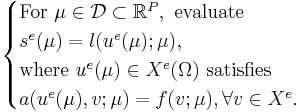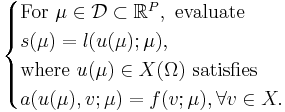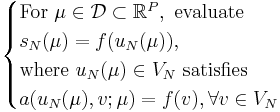| Line 120: | Line 120: | ||
<math> |
<math> |
||
| − | + | m(w,v;\mu) = \sum_{q=1}^{Q_m} \Theta_m^q(\mu,t) m^q(w,v) |
|
</math> |
</math> |
||
Revision as of 22:10, 19 November 2012
The Reduced Basis Method (RBM) we present here is applicable to static and time-dependent linear PDEs.
Time-Independent PDEs
The typical model problem of the RBM consists of a parametrized PDE stated in weak form with
bilinear form  and linear form
and linear form  .
The parameter
.
The parameter  is considered within a domain
is considered within a domain  and we are interested in an output quantity
and we are interested in an output quantity  which can be
expressed via a linear functional of the field variable
which can be
expressed via a linear functional of the field variable  .
.
The exact, infinite-dimensional formulation, indicated by the superscript e, is given by

We assume a large-scale discretization to be given, such that we consider

The underlying assumption of the RBM is that the parametrically induced manifold  can be approximated by a low dimensional space
can be approximated by a low dimensional space  .
.
It also applies the concept of an offline-online decomposition, in that a large pre-processing offline cost is acceptable in view of a very low online cost (of a reduced order model) for each input-output evaluation, when in a many-query or real-time context.
The essential assumption which allows the offline-online decomposition is that there exists an affine parameter dependence


The Lagrange Reduced Basis space is established by iteratively choosing Lagrange parameter samples

and considering the associated Lagrange RB spaces

in a greedy sampling. This leads to hierarchical RB spaces:  .
.
We then consider the galerkin projection onto the RB-space 

The greedy sampling uses an error estimator  which estimates (even rigorously, in some cases) the approximation error
which estimates (even rigorously, in some cases) the approximation error  .
.
Let  denote a finite sample of
denote a finite sample of  and set
and set  .
For
.
For  , find
, find  ,
and then set
,
and then set  .
.
Time-Dependent PDEs
When time is involved, it can be roughly considered as an usual parameter just as time-independent case.
But more attention should be paid to the dynamics of the system and the stability is also a major concern,
especially for the nonlinear case. Mostly, we use the same notation as time-independent case except the
variable  is added explicitly.
is added explicitly.
The exact, infinite-dimensional formulation, indicated by the superscript e, is given by
![\begin{cases}
\text{For } \mu \in \mathcal{D} \subset \mathbb{R}^P, t^k \in [0,T] \text{ evaluate } \\
s^e(\mu,t^k) = l(u^e(\mu,t);\mu), \\
\text{where } u^e(\mu,t) \in X^e(\Omega) \text{ satisfies } \\
m(u^e(\mu,t^k),v;\mu) + \Delta t a(u^e(\mu,t^k),v;\mu) = m(u^e(\mu,t^{k-1}),v;\mu) +
\Delta t f(v;\mu)u^e(\mu, t^k), \forall v \in X^e.
\end{cases}](/morwiki/images/math/2/5/0/2502798f3c978338082400fb691a0665.png) Here
Here  is also a bilinear form.
is also a bilinear form.
Assume a reference discretization form is given as follows,
![\begin{cases}
\text{For } \mu \in \mathcal{D} \subset \mathbb{R}^P, t^k \in [0,T] \text{ evaluate } \\
s(\mu,t^k) = l(u(\mu,t);\mu), \\
\text{where } u(\mu,t) \in X_{\mathcal N}(\Omega) \text{ satisfies } \\
m(u(\mu,t^k),v;\mu) + \Delta t a(u(\mu,t^k),v;\mu) = m(u(\mu,t^{k-1}),v;\mu) +
\Delta t f(v;\mu)u(\mu, t^k), \forall v \in X_{\mathcal N}.
\end{cases}](/morwiki/images/math/d/0/f/d0f1d97968db096c9a45f2dbe5d4f2f4.png)
The underlying assumption of the RBM is that the parametrically induced manifold  can be approximated by a low dimensional space
can be approximated by a low dimensional space  .
.
To apply the offline-online decomposition, we assume they are affine parameter-dependent, i.e.



The Lagrange Reduced Basis space  is usually established by POD-Greedy algorithm [2].
Then the following reduced model can be obtained by using Galerkin projection.
is usually established by POD-Greedy algorithm [2].
Then the following reduced model can be obtained by using Galerkin projection.
![\begin{cases}
\text{For } \mu \in \mathcal{D} \subset \mathbb{R}^P, t^k \in [0,T] \text{ evaluate } \\
s(\mu,t^k) = l(u_N(\mu,t);\mu), \\
\text{where } u_N(\mu,t) \in X_{N}(\Omega) \text{ satisfies } \\
m(u_N(\mu,t^k),v;\mu) + \Delta t a(u_N(\mu,t^k),v;\mu) = m(u_N(\mu,t^{k-1}),v;\mu) +
\Delta t f(v;\mu)u_N(\mu, t^k), \forall v \in X_N.
\end{cases}](/morwiki/images/math/1/9/a/19a97ba9278022a2f27e68901a50b082.png)
Note that the assumption of affine form can be relaxed in practice, then empirical interpolation [3] methods can be exploited for offline-online decomposition.
References
[1] M. Barrault, Y. Maday, N. Nguyen, and A. Patera, An `empirical interpolation' method: application to effcient reduced-basis discretization of partial differential equations, C. R. Math. Acad. Sci. Paris Series I, 339 (2004), 667-672.
[2] M. Grepl, Reduced--basis approximations and posteriori error estimation for parabolic partial differential equations, PhD thesis, MIT, 2005.
[3] B. Haasdonk and M. Ohlberger, Reduced basis method for finite volume approximations of parameterized linear evolution equations, Mathematical Modeling and Numerical Analysis, 42 (2008), 277-302.
[4] G. Rozza, D.B.P. Huynh, A.T. Patera Reduced Basis Approximation and a Posteriori Error Estimation for Affinely Parametrized Elliptic Coercive Partial Differential Equations, Arch Comput Methods Eng (2008) 15: 229–275.
Contact information:
